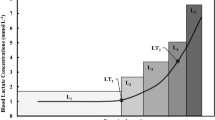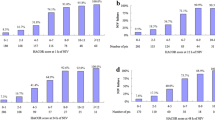Abstract
Objective. Fast paramagnetic oxygen analyzers have made it possible to measure inspiratory to end-tidal oxygen concentration difference (P(i-et)O2) breath-by-breath. It is now frequently displayed on monitors during routine anesthesia. We wanted to study the effects of major changes in metabolism, ventilation and circulation on P(i-et)O2. Methods. Ten healthy male volunteers were studied under exercise. P(i-et)O2 was measured with a fast-response paramagnetic differential oxygen sensor. Cardiac output was measured with non-invasive transthoracic electrical bioimpedance. Metabolism was measured with indirect calorimetry and ventilation with a side stream spirometer. After a rest period, the subjects cycled at 30W and 60W, 6 minutes on each work load and were then observed during 10 minutes of rest. Results. P(i-et)O2 corresponded well to V̇O2/V̇a (the oxygen uptake to alveolar ventilation quotient) correlation showed r = 0.79. P(i-et)O2 was influenced by changes in cardiac output which occurred primarily at the start and at the end of exercise. Expired minute ventilation (V̇e) multiplied by P(i-et)O2 was related to cardiac output with a high intrapersonal correlation. Conclusion. P(i-et)O2 is a good measure of adequate ventilation in relation to the oxygen consumption level and multiplied by V̇e it might offer a non-invasive bedside parameter indicating changes in cardiac output.
Similar content being viewed by others
References
Meriläinen PT. A fast differential paramagnetic O2-sensor. Int J Clin Monit Comput 1988; 5: 187–195
Meriläinen PT. A differential paramagnetic sensor for breath-by-breath oximetry. J Clin Monit 1990; 6: 65–73
Bengtsson J, Bengtsson A, Stenqvist O, Bengtson JP. Effects of hyperventilation on the inspiratory to end-tidal oxygen difference. Br J Anaesth 1994; 73: 140–144
Bengtsson J, Ederberg S, Stenqvist O, Bengtson JP. Do changes in cardiac output affect the inspiratory to end-tidal oxygen difference? Acta Anaesthesiol Scand 1995; 39: 1075–1079
Meriläinen PT. Metabolic monitor. Int J Clin Monit Comput 1987; 4:167–177
Takala J, Keinänen O, Väisänen P, Kari A. Measurement of gas exchange in intensive care: Laboratory and clinical validation of a new device. Crit Care Med 1989; 17: 1041–1047
Bernstein DP. Continuous noninvasive real-time monitoring of stroke volume and cardiac output by thoracic electrical bioimpedance. Crit Care Med 1986; 14: 898–901
Jewkes C, Sear JW, Verhoeff F, Sanders DJ, Foex P. Noninvasive measurement of cardiac output by thoracic electrical bioimpedance: a study of reproducibility and comparison with thermodilution. Br J Anaesth 1991; 67: 788–794
Sramec BB. Hemodynamic and pump-performance monitoring by electrical bioimpedance. Problems in Respiratory Care 1989; 2: 274–290
Nunn JF. Nunn’s applied respiratory physiology. Oxford: Butterworth-Heinemann Ltd, 1993
Schoene RB. Physiology of exercise. In: Pierson DJ, Kacmarek RM, eds. Foundations of Respiratory Care. New York: Churchill Livingstone, 1992: 135–139
Diamond L, Casaburi R, Wasserman K, Whipp BJ. Kinetics of gas exchange and ventilation in transitions from rest or prior exercise. J Appl Physiol 1977; 43: 704–708
Wasserman K. Breathing during exercise. N Engl J Med 1978; 298: 780–785
Jones NL, McHardy CJR, Naimark A. Physiological dead space and alveolar-arterial gas pressure differences during exercise. Clin Sci 1966; 31: 19–29
Eberhard P, Mindt W, Schäfer R. Cutaneous blood gas monitoring in the adult. Crit Care Med 1981; 9: 702–705
Hesser CM, Matell G. Effects of light and moderate exercise on alveolar-arterial O2 tension difference in man. Acta Physiol Scand 1965; 63: 247–256
Nunn JF. Nunn’s applied respiratory physiology. Oxford: Butterworth-Heinemann Ltd, 1993
Gueugniaud P-Y, Muchada R, Bertin-Maghit M, Griffith N, Petit P. Non-invasive continuous haemodynamic and PetCO2 monitoring during peroperative cardiac arrest. Can J Anaesth 1995; 42: 910–913
Morimoto Y, Kemmotsu O, Murakami F, Yamamura T, Mayumi T. End-tidal CO2 changes under constant cardiac output during cardiopulmonary resuscitation. Crit Care Med 1993; 21:1572–1576
Weil MH, Bisera J, Trevino RP, Rackow EC. Cardiac output and end-tidal carbon dioxide. Crit Care Med 1985; 13: 907–909
Isserles SA, Breen PH. Can changes in end-tidal PCO2 measure changes in cardiac output? Anesth Analg 1991; 73: 808–814
Shibutani K, Muraoka M, Shirasaki S, Kubal K, Sanchala VT, Gupte P. Do changes in end-tidal PCO2 quantitatively reflect changes in cardiac output. Anesth Analg 1994; 79: 829–833
Nunn JF. Nunn’s applied respiratory physiology. Oxford: Butterworth-Heinemann Ltd, 1993
Baker RW, Burki NK. Alterations in ventilatory to tidal volume. pattern and ratio of dead space to tidal volume. Chest 1987; 92: 1013–1017
Author information
Authors and Affiliations
Rights and permissions
About this article
Cite this article
Bengtsson, J., Bengtson, J.P. The inspiratory to end-tidal oxygen difference during exercise. Int. J. Clin. Mon. Comp. 14, 217–223 (1997). https://doi.org/10.1007/BF03356566
Accepted:
Published:
Issue Date:
DOI: https://doi.org/10.1007/BF03356566




